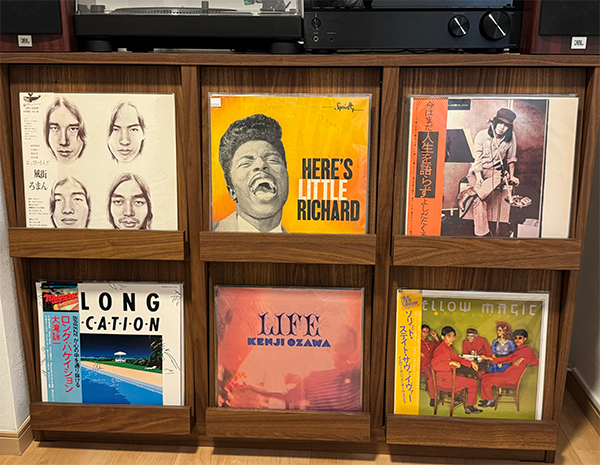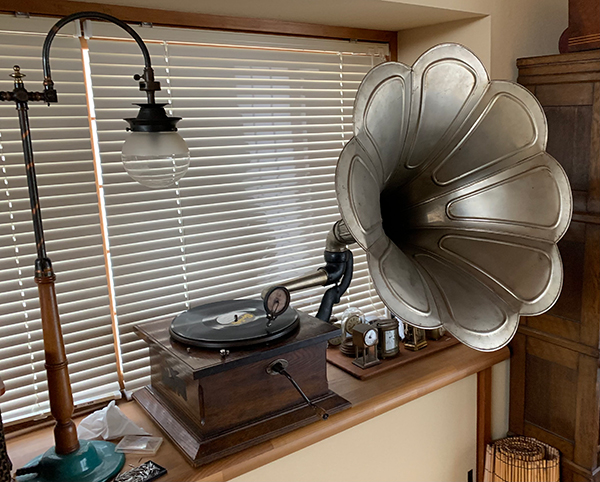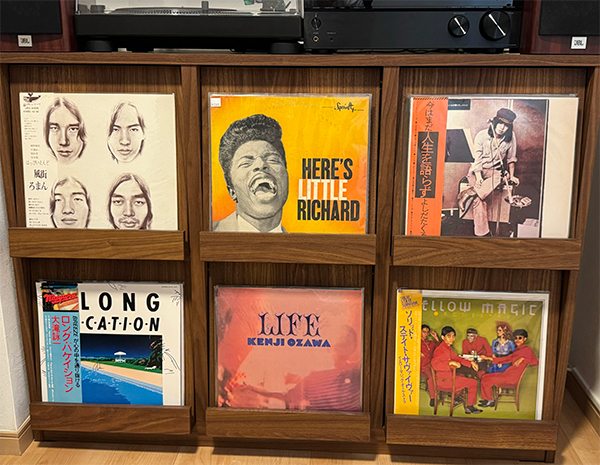2024.9.19
Gallerist's small episodes vol.9| Attractive of vinyl records

【EIJI KUROKAWA director of Kurokawa gallery】
This is my first time writing a blog like this, and when I thought about what to write about, the first thing that came to mind was music, so I decided to write about it.
My hobby is collecting vinyl records, and I especially like Western and Japanese music from the 1950s to the 1990s, and have been listening to them since I was a child.
When you listen to vinyl records, the warm sound that you can't get with digital music feels very comfortable.
Among them, listening to early vinyl records on a gramophone is amazing.

▲Listening to a 78 rpm vinyl record on a gramophone. When you turn the mainspring on the handle in front of you, the turntable with the record on it spins, and when you slowly drop the needle onto it, it makes a sound.
Little Richard's 1957 "Lucille" is playing.
Explosive sound.
There are different types of records depending on the rotation speed, mainly
78 revolutions
45 rotations
33 rotations
There are 3 types of rotation speeds.
78 RPM is the speed of early records, which had a high RPM and were produced until around 1960, when only about one song was recorded.
45 rpm is called a donut disc or single disc, and the rotation speed is a little slow, and it is the mainstream of records produced from the 1960s to the early 1990s.
33rpm is mainly used for albums, can record multiple songs, and is slower than 45rpm.
In recent years, due to the popularity of city pop and Showa era music, the popularity of records has increased, and even today's musicians are releasing new songs on records (mainly 45 rpm discs).
Many record players are also on sale, which shows how popular they are.
However, recent record players only have playback speeds of 45 and 33 rpm.
The reason for this is that 78rpm records were created until around 1960, so not many people listen to records from that time, and there are not many collectors of 78rpm records. Even if you have listened to it, it has been pressed many times on 45rpm and 33rpm records from the 1960s, so you can listen to it there.
To put it simply, I don't listen to CDs because I can listen to them digitally.
When you listen to 78 RPM, which can be said to be the origin of records, on a phonograph, the sound is very powerful, and the scale is close to the real sound as if you were listening to it right in front of your eyes.
I especially like early rock music from the late 1950s, and I listen to my favorite artists who created the rock genre, such as Little Richard and Elvis Presley, and it's truly overwhelming and moving.

▲33rpm records.
In particular, the masterpiece in the middle of the top row is the 1957 album "HERE'S LITTLE RICHARD" by Little Richard.
He is such a great musician that it is said that without him, there would be no Beatles, Rolling Stones, Bob Dylan, David Bowie, and the music we have today would be different.
From the top left, Happy End's ``Kazemachi Roman'', right is Takuro Yoshida, ``Now I Don't Talk About Life'', bottom left, Eiichi Otaki, ``A LONG VACATION'', commonly known as Lombake, Kenji Ozawa, ``LIFE'', YMO ``Solid''. State Survivor”.
It would be too much to explain each one, so I'll stop here. .
The music you listen to on records has detailed sounds that cannot be reproduced or captured digitally. Even if you listen to the same song and compare, the impression of each song will be completely different.
Was there a sound like this in this part? Or, here's this chorus! There are new small discoveries such as these that cannot be enjoyed digitally.
I think that's the biggest appeal of records.
【EIJI KUROKAWA director of Kurokawa gallery】
---------------------------------------------------------------------------------
ギャラリー黒川 Gallery Kurokawa
10:00 - 18:00
〒104-0031 東京都中央区京橋3-3-4 京橋日英ビル1階
2F, 3-5-21 Kyobashi, Chuo-ku, Tokyo 104-0031
TEL:+813-6228-7888
WEB:https://gallerykurokawa.com/
---------------------------------------------------------------------------------
"Gallerist's small episodes'' features contributions from unique shopkeepers who set up shops in this artistic town. If you have any interest in art, the town, or anything else, please come visit the owner's shop and listen to what he has to say.
